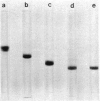Abstract
The development of methods for the production of intact Cμ3 and Cμ4 domains of IgM have made possible the assessment of some of their structural and biological functions. Antiserum against Fcμ fragment detected both domains and illustrated their complete antigenic non-identity. Circular dichroism spectroscopy and the retention of antigenicity indicated that both domains had retained most of their native structure. No interaction of the type Cμ3—Cμ3, Cμ4—Cμ4 or Cμ3—Cμ4 could be detected under non-dissociating conditions by analytical ultracentrifugation or molecular exclusion chromatography experiments. These results lead us to believe that the transmission of effector messages between the Fab and Fc parts of IgM takes place through structural changes at the quaternary level.
C[unk]1-fixation experiments with IgM and several of its fragments and domains show that (a) the Cμ4 domain contains the C[unk]1-fixing site; (b) the high C[unk]1-fixing capacity of IgM or Fc5μ cannot be explained on the basis of a simple accumulative model of complement fixing domains; (c) the C[unk]1-fixing site is independent of the native structure of the Cμ4 domain; (d) the C[unk]1-fixing site does not contain carbohydrate.
Examination of the IgM receptor on the surface of human T lymphocytes show that (a) Cμ4 domain is primarily responsible for the reaction and Cμ3 domain has very little affinity; (b) native structure is essential for the reaction because reduction and alkylation of the Cμ4 domain destroyed both its original conformation and affinity for this receptor; (c) IgM and Fc5μ had a much greater affinity for the receptor than monomeric subunits: (d) carbohydrate on Cμ4 domain is not involved in the affinity reaction.
Full text
PDF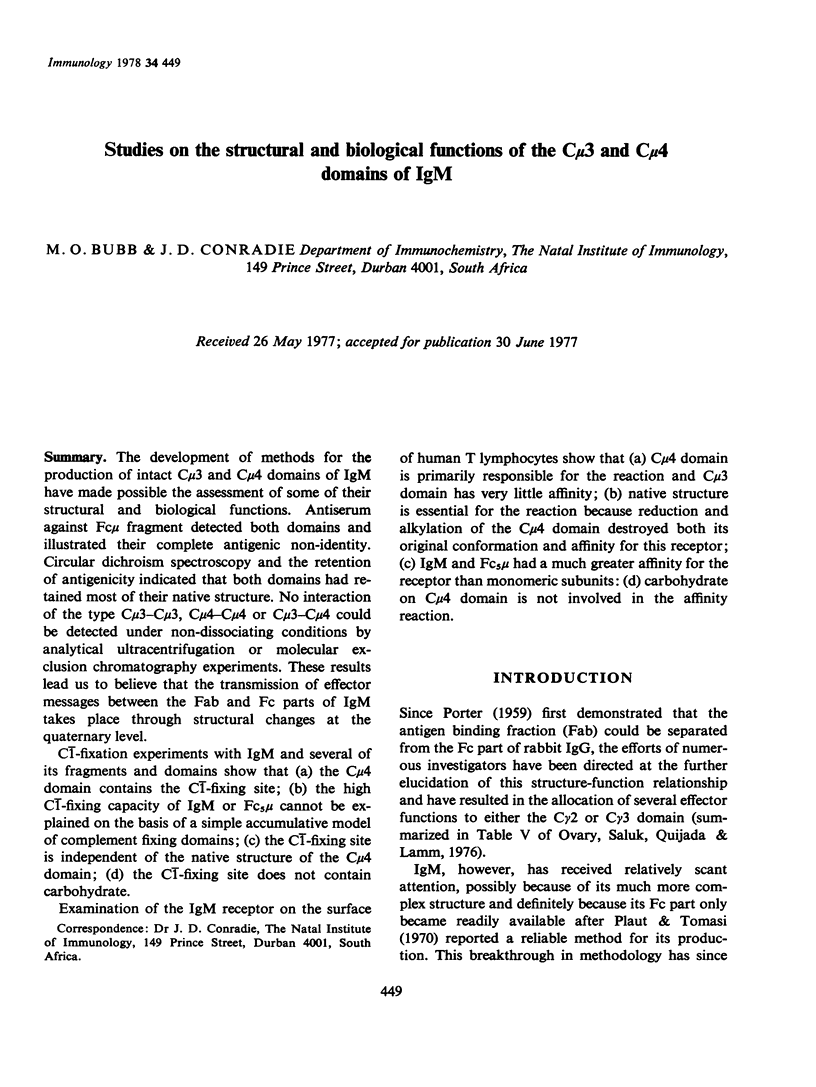
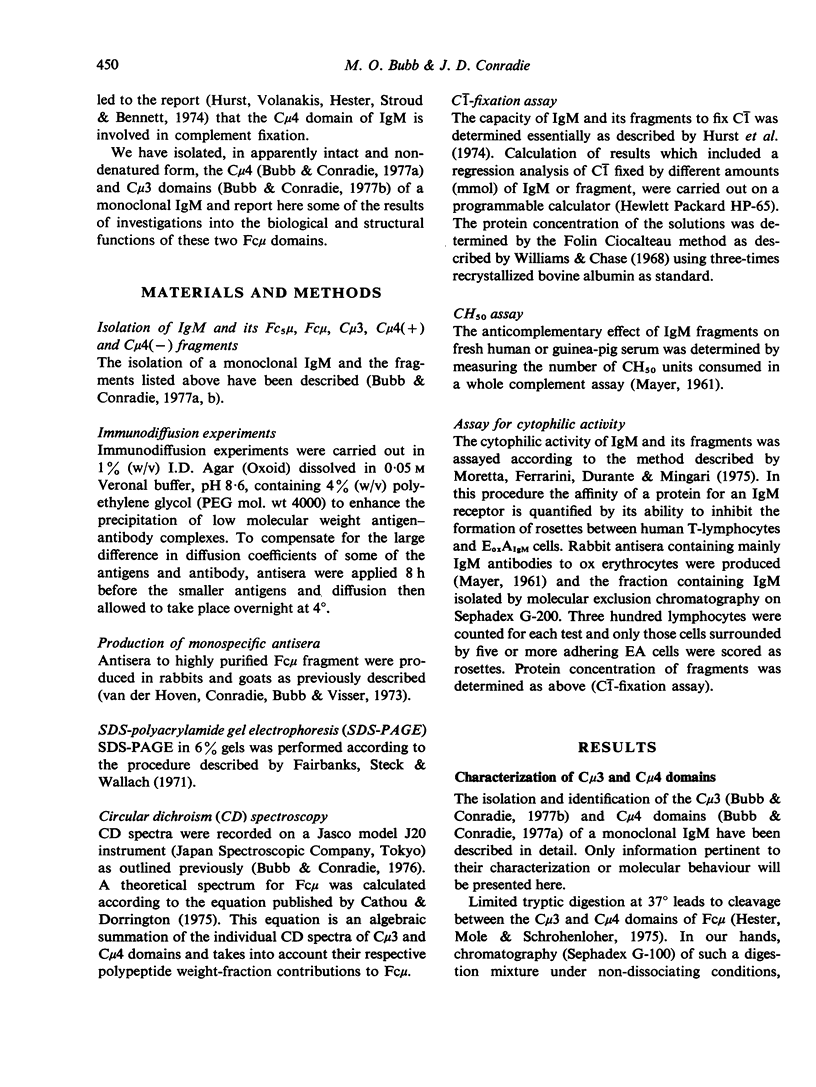
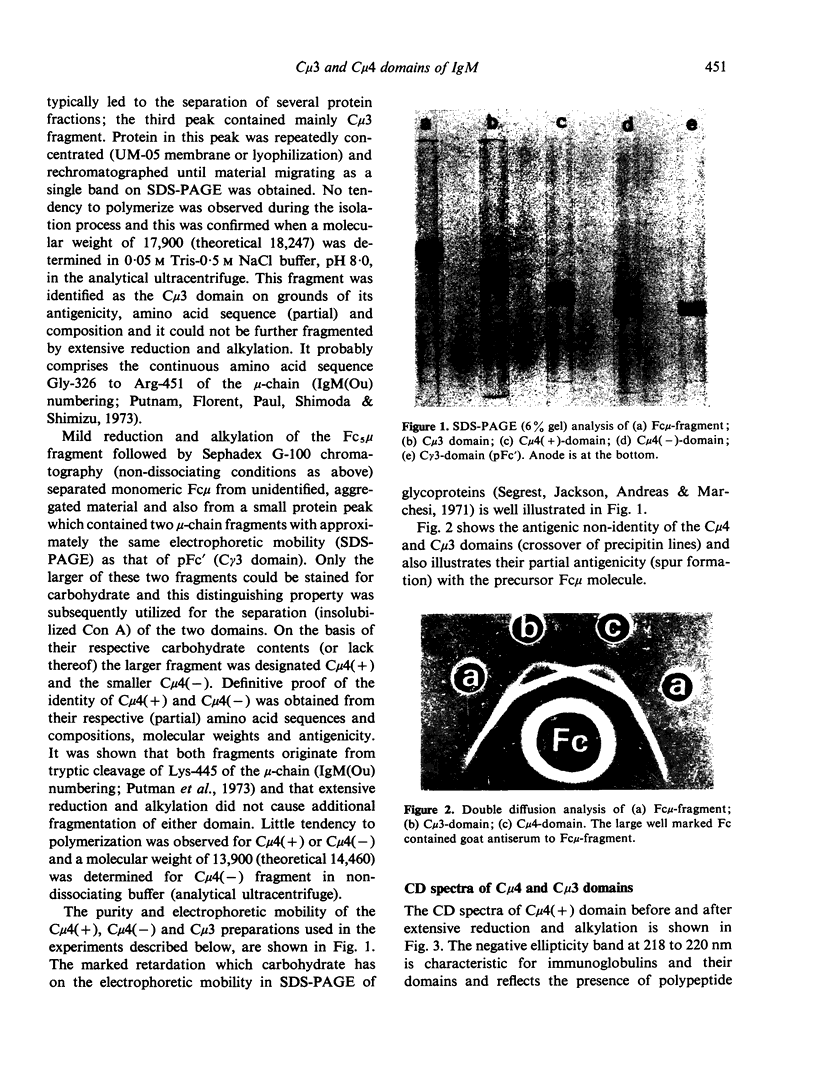
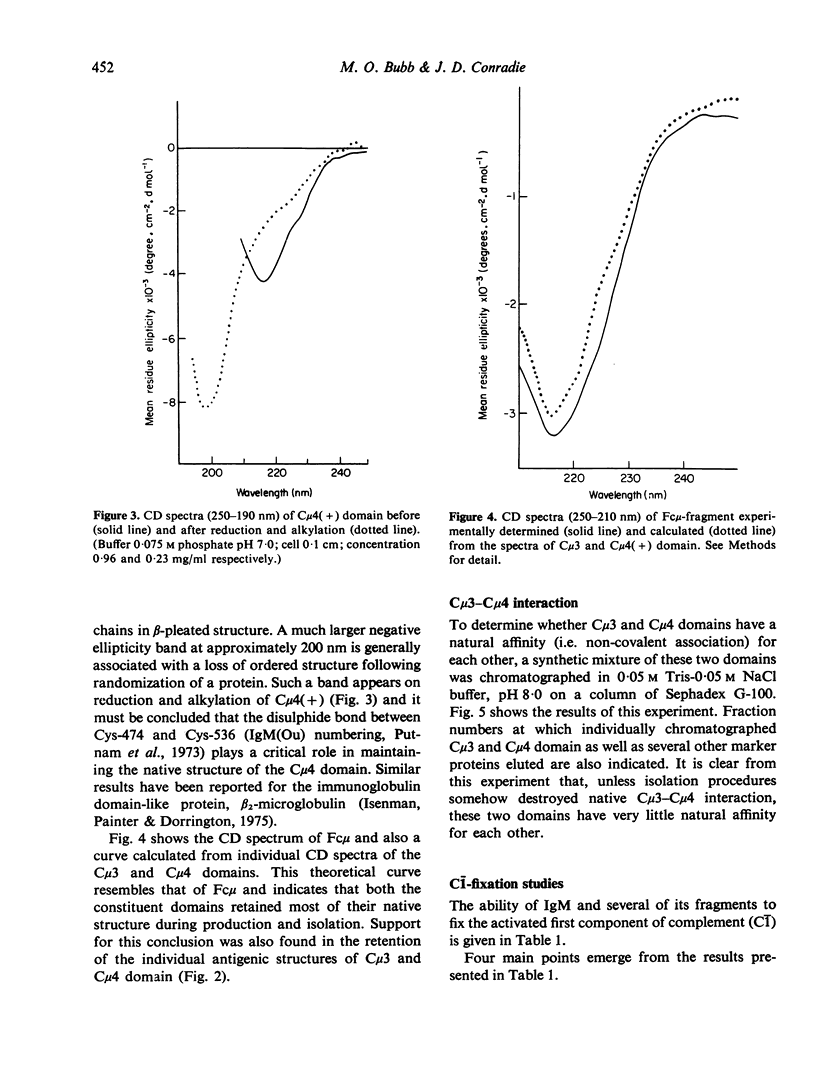
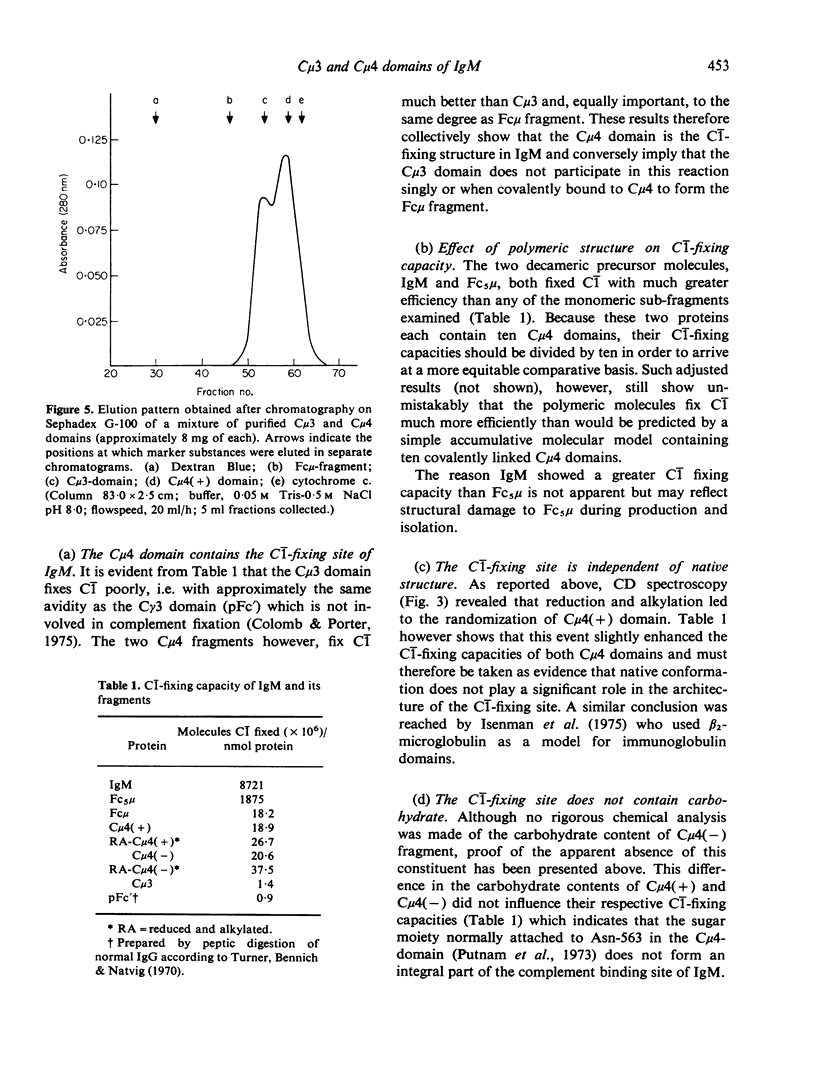
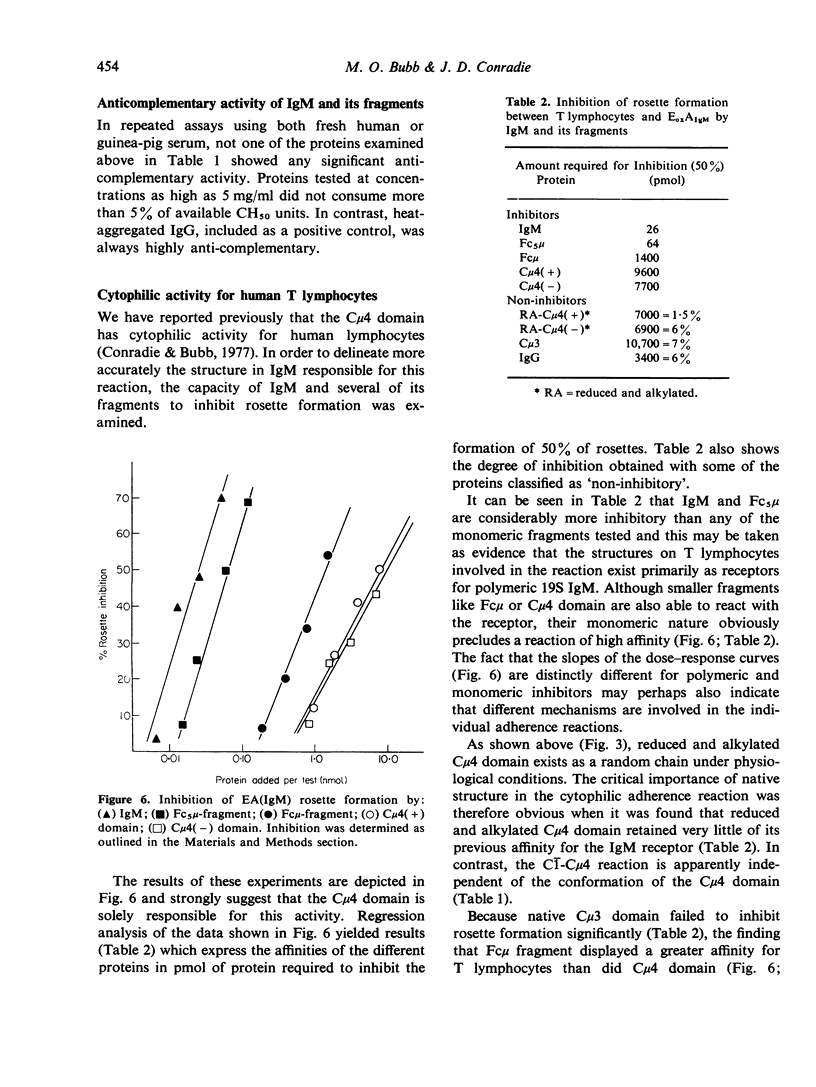
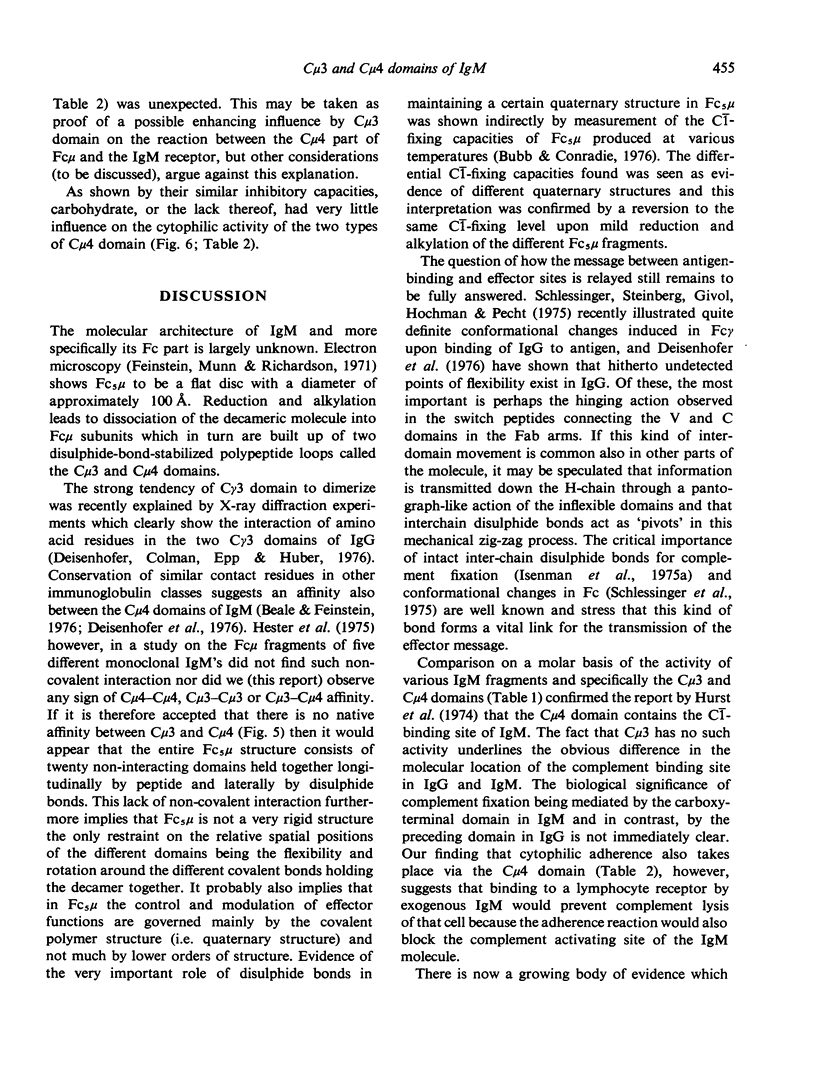
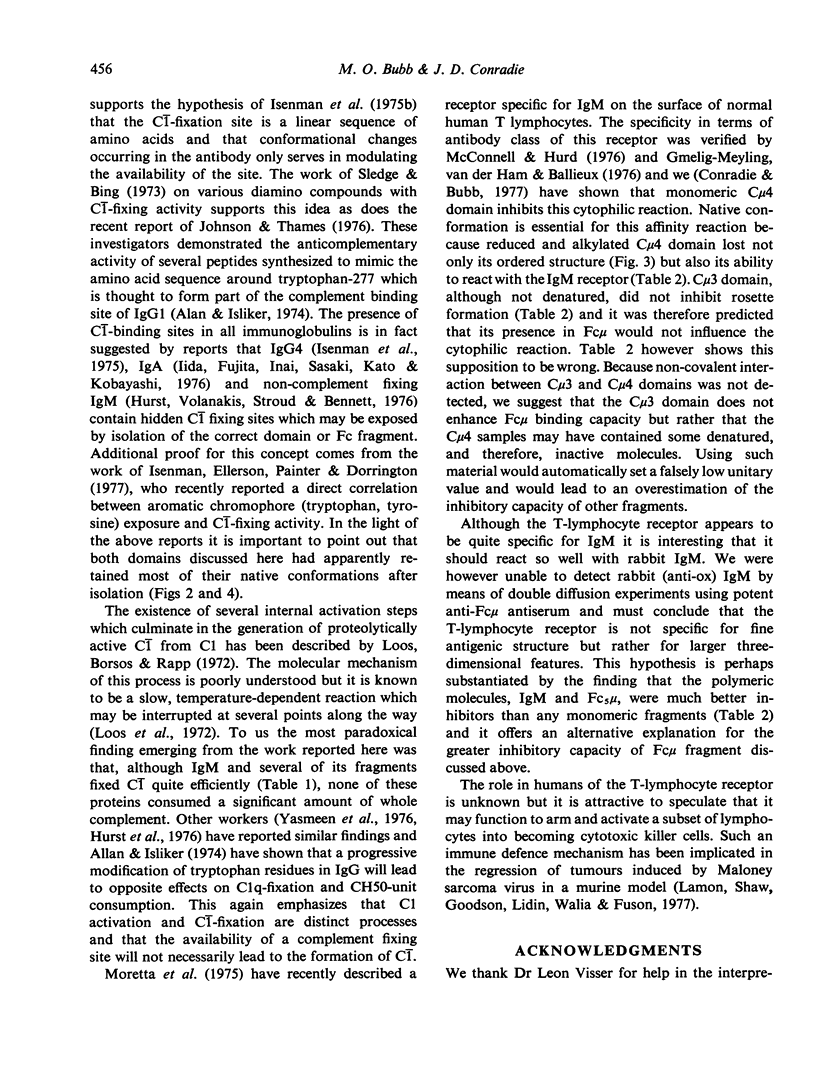
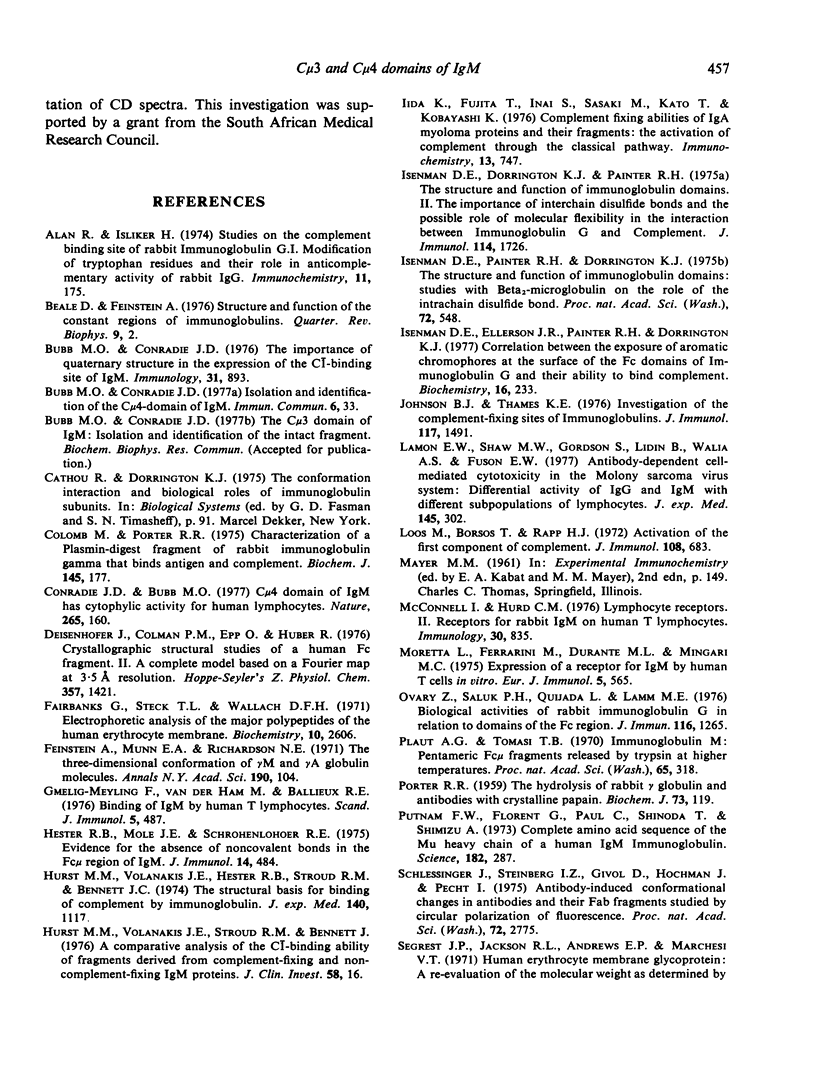
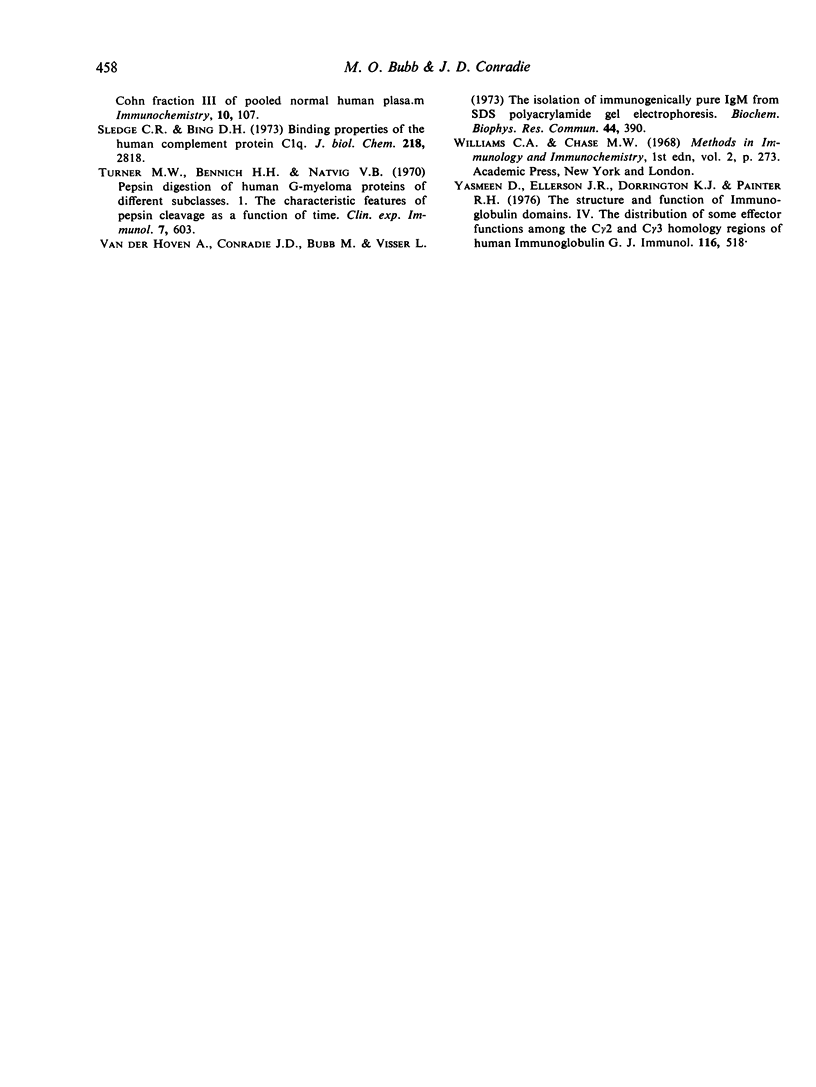
Images in this article
Selected References
These references are in PubMed. This may not be the complete list of references from this article.
- Allan R., Isliker H. Studies on the complement-binding site of rabbit immunoglobulin G. I. Modification of tryptophan residues and their role in anticomplementary activity of rabbit IgG. Immunochemistry. 1974 Apr;11(4):175–180. doi: 10.1016/0019-2791(74)90325-5. [DOI] [PubMed] [Google Scholar]
- Bubb M. O., Conradie J. D. Isolation and identification of the Cmicron4-domain of IgM. Immunol Commun. 1977;6(1):33–47. doi: 10.3109/08820137709055802. [DOI] [PubMed] [Google Scholar]
- Bubb M. O., Conradie J. D. The importance of quaternary structure in the expression of the C1-binding site of IgM. Immunology. 1976 Dec;31(6):893–902. [PMC free article] [PubMed] [Google Scholar]
- Colomb M., Porter R. R. Characterization of a plasmin-digest fragment of rabbit immunoglobulin gamma that binds antigen and complement. Biochem J. 1975 Feb;145(2):177–183. doi: 10.1042/bj1450177. [DOI] [PMC free article] [PubMed] [Google Scholar]
- Conradie J. D., Bubb M. O. Cmu4 domain of IgM has cytophilic activity for human lymphocytes. Nature. 1977 Jan 13;265(5590):160–161. doi: 10.1038/265160a0. [DOI] [PubMed] [Google Scholar]
- Deisenhofer J., Colman P. M., Epp O., Huber R. Crystallographic structural studies of a human Fc fragment. II. A complete model based on a Fourier map at 3.5 A resolution. Hoppe Seylers Z Physiol Chem. 1976 Dec;357(10):1421–1434. doi: 10.1515/bchm2.1976.357.2.1421. [DOI] [PubMed] [Google Scholar]
- Fairbanks G., Steck T. L., Wallach D. F. Electrophoretic analysis of the major polypeptides of the human erythrocyte membrane. Biochemistry. 1971 Jun 22;10(13):2606–2617. doi: 10.1021/bi00789a030. [DOI] [PubMed] [Google Scholar]
- Feinstein A., Munn E. A., Richardson N. E. The three-dimensional conformation of M and A globulin molecules. Ann N Y Acad Sci. 1971 Dec 31;190:104–121. doi: 10.1111/j.1749-6632.1971.tb13526.x. [DOI] [PubMed] [Google Scholar]
- Gmelig-Meyling F., Van der Ham M., Ballieux R. E. Binding of IgM by human T lymphocytes. Scand J Immunol. 1976;5(5):487–495. doi: 10.1111/j.1365-3083.1976.tb00303.x. [DOI] [PubMed] [Google Scholar]
- Hurst M. M., Volanakis J. E., Hester R. B., Stroud R. M., Bennett J. C. The structural basis for binding of complement by immunoglobulin M. J Exp Med. 1974 Oct 1;140(4):1117–1121. doi: 10.1084/jem.140.4.1117. [DOI] [PMC free article] [PubMed] [Google Scholar]
- Hurst M. M., Volanakis J. E., Stroud R. M., Bennett J. C. A comparative analysis of the C1-binding ability of fragments derived from complement-fixing and noncomplement-fixing IgM proteins. J Clin Invest. 1976 Jul;58(1):16–21. doi: 10.1172/JCI108445. [DOI] [PMC free article] [PubMed] [Google Scholar]
- Iida K., Fujita T., Inai S., Sasaki M., Kato T. Complement fixing abilities of IgA myeloma proteins and their fragments: the activation of complement through the classical pathway. Immunochemistry. 1976 Sep;13(9):747–752. doi: 10.1016/0019-2791(76)90195-6. [DOI] [PubMed] [Google Scholar]
- Isenman D. E., Dorrington K. J., Painter R. H. The structure and function of immunoglobulin domains. II. The importance of interchain disulfide bonds and the possible role of molecular flexibility in the interaction between immunoglobulin G and complement. J Immunol. 1975 Jun;114(6):1726–1729. [PubMed] [Google Scholar]
- Isenman D. E., Ellerson J. R., Painter R. H., Dorrington K. J. Correlation between the exposure of aromatic chromophores at the surface of the Fc domains of immunoglobulin G and their ability to bind complement. Biochemistry. 1977 Jan 25;16(2):233–240. doi: 10.1021/bi00621a012. [DOI] [PubMed] [Google Scholar]
- Isenman D. E., Painter R. H., Dorrington K. J. The structure and function of immunoglobulin domains: studies with beta-2-microglobulin on the role of the intrachain disulfide bond. Proc Natl Acad Sci U S A. 1975 Feb;72(2):548–552. doi: 10.1073/pnas.72.2.548. [DOI] [PMC free article] [PubMed] [Google Scholar]
- Johnson B. J., Thames K. E. Investigations of the complement-fixing sites of immunoglobulins. J Immunol. 1976 Nov;117(5 Pt 1):1491–1494. [PubMed] [Google Scholar]
- Lamon E. W., Shaw M. W., Goodson S., Lidin B., Walia A. S., Fuson E. W. Antibody-dependent cell-mediated cytotoxicity in the Moloney sarcoma virus system: differential activity of IgG and IgM with different subpopulations of lymphocytes. J Exp Med. 1977 Feb 1;145(2):302–313. doi: 10.1084/jem.145.2.302. [DOI] [PMC free article] [PubMed] [Google Scholar]
- Loos M., Borsos T., Rapp H. J. Activation of the first component of complement evidence for an internal activation step. J Immunol. 1972 Mar;108(3):683–688. [PubMed] [Google Scholar]
- McConnell I., Hurd C. M. Lymphocyte receptors. II. Receptors for rabbit IgM on human T lymphocytes. Immunology. 1976 Jun;30(6):835–839. [PMC free article] [PubMed] [Google Scholar]
- Moretta L., Ferrarini M., Durante M. L., Mingari M. C. Expression of a receptor for IgM by human T cells in vitro. Eur J Immunol. 1975 Aug;5(8):565–569. doi: 10.1002/eji.1830050812. [DOI] [PubMed] [Google Scholar]
- Ovary Z., Saluk P. H., Quijada L., Lamm M. E. Biologic activities of rabbit immunoglobulin G in relation to domains of the Fc region. J Immunol. 1976 May;116(5):1265–1271. [PubMed] [Google Scholar]
- PORTER R. R. The hydrolysis of rabbit y-globulin and antibodies with crystalline papain. Biochem J. 1959 Sep;73:119–126. doi: 10.1042/bj0730119. [DOI] [PMC free article] [PubMed] [Google Scholar]
- Plaut A. G., Tomasi T. B., Jr Immunoglobulin M: pentameric Fcmu fragments released by trypsin at higher temperatures. Proc Natl Acad Sci U S A. 1970 Feb;65(2):318–322. doi: 10.1073/pnas.65.2.318. [DOI] [PMC free article] [PubMed] [Google Scholar]
- Putnam F. W., Florent G., Paul C., Shinoda T., Shimizu A. Complete amino acid sequence of the Mu heavy chain of a human IgM immunoglobulin. Science. 1973 Oct 19;182(4109):287–291. doi: 10.1126/science.182.4109.287. [DOI] [PubMed] [Google Scholar]
- Schlessinger J., Steinberg I. Z., Givol D., Hochman J., Pecht I. Antigen-induced conformational changes in antibodies and their Fab fragments studied by circular polarization of fluorescence. Proc Natl Acad Sci U S A. 1975 Jul;72(7):2775–2779. doi: 10.1073/pnas.72.7.2775. [DOI] [PMC free article] [PubMed] [Google Scholar]
- Sledge C. R., Bing D. H. Binding properties of the human complement protein Clq. J Biol Chem. 1973 Apr 25;248(8):2818–2823. [PubMed] [Google Scholar]
- Turner M. W., Bennich H. H., Natvig J. B. Pepsin digestion of human G-myeloma proteins of different subclasses. I. The characteristic features of pepsin cleavage as a function of time. Clin Exp Immunol. 1970 Nov;7(5):603–625. [PMC free article] [PubMed] [Google Scholar]
- Yasmeen D., Ellerson J. R., Dorrington K. J., Painter R. H. The structure and function of immunoglobulin domains. IV. The distribution of some effector functions among the Cgamma2 and Cgamma3 homology regions of human immunoglobulin G1. J Immunol. 1976 Feb;116(2):518–526. [PubMed] [Google Scholar]



